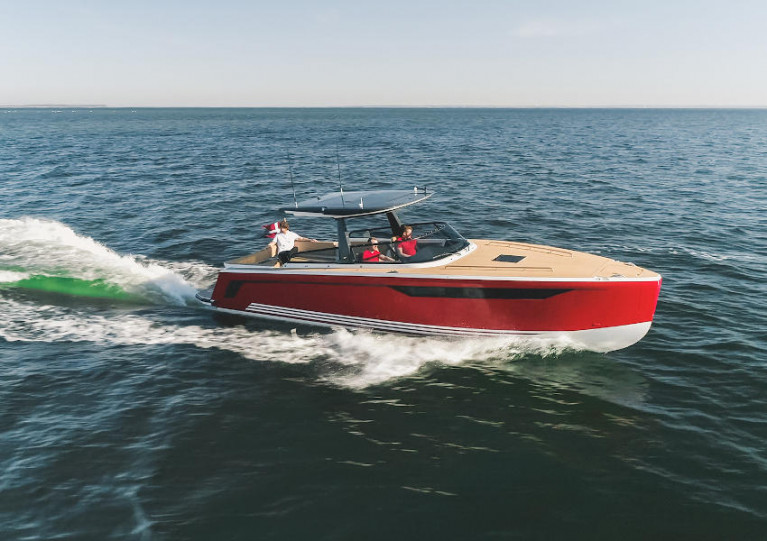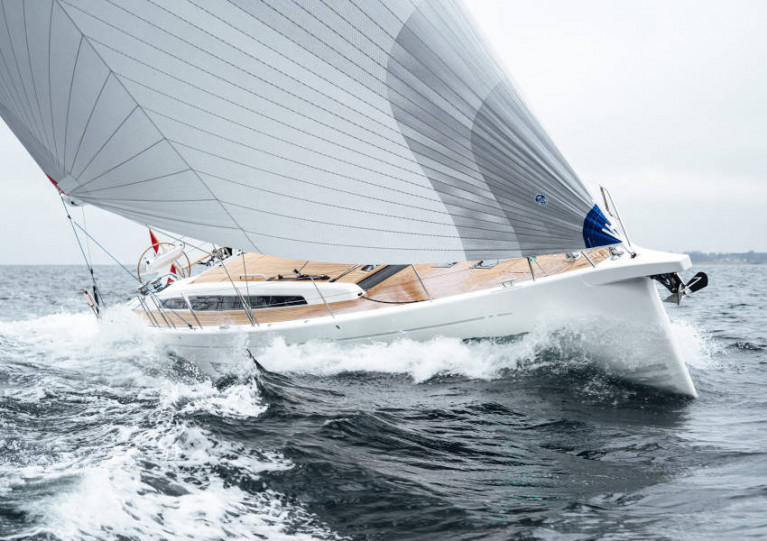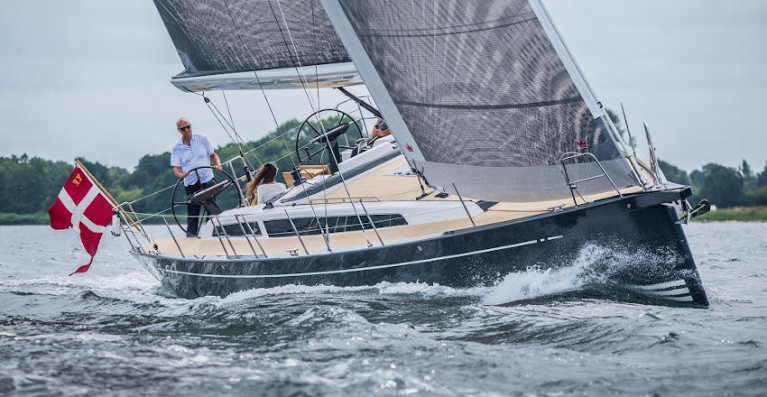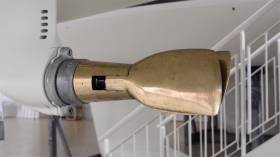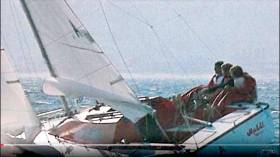Displaying items by tag: X yachts
With the healthy sailing season bursting into life all around us - and doing so almost regardless of the various stages of pandemic-emergence ashore - there’s a shortage of quality used boats available worldwide, and particularly in Ireland.
So news of any "boat of note" coming to the market in perfect ready-to-go condition is like a firework going off, and Afloat.ie draws your attention to the very well-known Dun Laoghaire-based Xp44 WOW which - according to this link to X Yachts - will be “available from early July". More here
New Look, New Era on Horizon for X-Yachts’ X4³
One of most popular X-Yachts models, the X4³, is going through a serious makeover process.
This boat was the first model in the Pure X range and was introduced to the world for the first time in 2016. Since then more than 100 have been sold globally via X-Yachts’ international dealer network.
X4³s can be found in Australia, Argentina, USA and Canada throughout the whole of Europe and in Russia and China.
Thomas Mielec, X-Yachts’ director of design and engineering, explains: “What we are developing now can be described as a smaller version of the X5⁶.
“The development of the X4³ is considered to be a natural evolution incorporating the lessons learned and the visual appearance of especially the X4⁶ and X4⁰, and after having launched the X56, we saw some opportunities for the X4³ that will lift her to an even higher level”.
Redesigned hull and S-bow design
The redesigned hull shape features wider stern sections above the waterline with the Bmax brought further aft and with soft chines. This increases the downwind performance and allows for a much wider cockpit aft.
Also, the S-bow design and integrated standard bow sprit as standard introduced by the X56 has been incorporated.
The mast height and hence the sail plan has been increased compared to the present model to add to the performance and keep her more in line with the other members of the Pure X range. The longer bow sprit allows for bigger and more free flying gennakers.
Deck and sprayhood
The deck and deck liner have been completely redesigned. The appearance of the coachroof and coamings is brought to the more modern styling of the other Pure X models — and beyond.

The deck layout features longitudinal jib tracks as standard, but a self-tacking track recessed into the cabin top — as known from the newer Pure Xes — is available as an option. However, when this option is not chosen, the recess will be covered so that the aesthetic flush appearance of the cabin top is maintained.
The cabin-side port lights are designed with the same type of openable sections as on the X4⁶ and X4⁰, allowing for better ventilation and a simpler aesthetic appearance.
The cruising sailor can look forward to a redesigned sprayhood layout. Apart from protecting the family from hard weather at sea, the shape of the sprayhood will offer a sleeker visual appearance and a better forward view for the helmsman than on previous designs.
Spacious cockpit
The cockpit area is wider and more spacious and at the companionway the hinged acrylic doors and integrated rope storage at the sides (known from the X4⁰) are adopted.
The interior
The revised hull shape and slightly raised cockpit floor allows for enhanced width of the berths in the aft cabin/s and the tables and wash basins in the heads have been improved and modernised, but apart from that only minor features will be redesigned in the interior of the X4³.
“There is no need to change things that work optimally, so for now, we decided to maintain the layouts of the interior,” Mielec says.
X-Yachts expects to launch the refreshed X4³ in January 2022, with prices stating from €344,000 ex VAT. Find out more on the X-Yachts website, and click HERE to request a call-back regarding this yacht.
X-Yachts welcomes everyone to experience first-hand the soul and heritage of its brand at the South Coast Boat Show in Southampton this coming weekend.
As previously reported on Afloat.ie, the X4⁹ will be part of X-Yachts’ presence at Ocean Village Marina from Friday 7 to Sunday 9 May.
Viewing slots are in high demand, with limited times available HERE.
X-Yachts Team Take ‘The Red Baron’ X-Power 33C Out for a Spin
Spring has sprung in Denmark, prompting the X-Yachts team to take the new X-Power 33C — dubbed ‘The Red Baron’ — out of the Haderslev yard.
Chief executive Kræn Brinck Nielsen joined Kasper Brinck Mair and Martin Lindbæk, sales manager for the X-Power range, for the spin on the water just weeks after its world premiere unveiling.
As previously reported on Afloat.ie, the X-Power 33C marks X-Yachts’ first foray into the powerboat market following the acquisition of Swedish builder HOC Yachts in late 2019.
In other news, X-Yachts recently celebrated the 40th anniversary of the X-102.
The X-102 is the second X-Yachts model launched and it was a true cruiser/racer with a centre cockpit. The boat was designed for IOR’s 3/4 ton upper rating limit of 24.55ft.
X-102 “Soldier Blue” won the 3/4 Ton World Championship in 1981 and was skippered by Ib Ussing Andersen, helmed by Jens Christensen with tactics by Lars Bo Ive, all now of North Sails fame.
Lars and Niels Jeppesen did also participate in the same championship, in another X-102, taking the seventh place.
In 1982, “Lille du” won the same title and gave X-Yachts a head start in the international yachting arena.
One of the star qualities of the X-102 and indeed all other X-Yachts models is sailing pleasure, as a recent video on the X-Yachts YouTube channel attests:
X-Yachts Announces ‘Roadmap’ for UK Events in 2021
X-Yachts has unveiled a busy calendar of in-person events in Southampton from spring to autumn of 2021, restrictions allowing.
The schedule kicks off with a chance to experience the X4⁹ at Hamble Point Marina from 9-11 April. Reservations for time aboard are limited; email Stuart Abernathy.
The X4⁹ will also be part of X-Yachts’ presence at the South Coast Boat Show at Ocean Village Marina from 7-9 May. While slots have already been booked out, prospective viewers can join the waiting list.
Later that month is the X-Yachts Solent Cup, which will also see a private X-Yachts owners event at the Royal Southern Yacht Club over the weekend of 28-30 May.
The next dates for your diary at 2-4 July, when X-Yachts hosts its Experience the X5⁶ premiere at Hamble Point Marina. This will be followed by an Experience the Brand event with various X-Yachts models on display from 6-8 August.
September brings the Ocean Village Boat Show and the premiere of the X-Power 33C at Ocean Village Marina from 10-19 September.
And there will be another chance to see the X-Power 33 in the Experience the Brand event at Hamble Point Marina from 8-9 October.
Full details will follow in advance of each event in the calendar. Admission to all is strictly by appointment only, to ensure a safe and relaxed customer experience.
Make your yachting dreams a reality this summer and become the owner of a brand-new X-Yachts X4⁰ for delivery this July.
The top performance cruiser in the 2020 European Yacht of the Year awards can be delivered to the UK by road or sea, or to the EU for UK residents to avail of VAT-free status.
The X4⁰ comes in a variety of configurations which you can choose to suit your own desires on the X-Yachts website, which also hosts a virtual tour inside the luxury performance vessel.
Please note that this boat is only available to residents of the UK or Ireland or for Greek charter.
For more, call Stuart Abernathy on +44 7500 947896 or email [email protected]
And don’t miss X-Yachts’s other smash-hit new models, the Pure X flagship X5⁶ and its surge into the powerboat market with the X-Power 33C.
Last Chance to Own a New X-Yacht in 2021
X-Yachts’ Danish yard has only a limited number of build slots left for sailing in the 2021 season, restrictions allowing.
If you are ready to use sailing as your ‘escape’ in 2021, you can choose from the X4⁰, X4³, X4⁶, Xc 38 and Xc 45 for delivery in August and September this year.
Besides the recommended sailing specifications, all come with a complimentary bow thruster, engine power upgrade, and road transport and commissioning in Hamble.
This special offer is only valid until 31 January and its subject to contract. Contact Stuart Abernathy at [email protected] for more.
Yesterday X-Yachts officially unveiled the X-Power 33C, its first foray into the powerboat market, as previously reported on Afloat.ie.
Ensuring there’s no unnecessary high resistance in the water is one key to the success of X-Yachts hull designs over the years, as CEO and founder Niels Jeppesen explains in the latest instalment of its video series, which you can watch below.
Jeppesen highlights features such as hinged propellers that close into a fin shape when not in use, retractable bow thrusters, and optimise placement of water tanks among features that make their boats’ handling a breeze in or out of the marina.
Previously, Jeppesen covered how the Danish sailing yacht builder arrived at its unique brand name.
X Yachts Celebrate 40th Anniversary (Video)
The 10th February 1979 was a big day in the life of Danish Yacht Firm X Yachts. Niels Jeppesen and Birger Hansen officially started up the company at precisely 8 am.
Lars Jeppesen, having recently finished his education as a boat builder was travelling for 3 months…
Niels and Birger simply couldn’t wait – they had to start up the project. So… on 10th February, the drawings for the racing sailboat of 7.8 metres were ready. And on this particular date, the two guys started producing the plug for the hull. They both looked forward to surprising Lars when he came back from his journey.
In this process, the plug was extended by 10 cm. The boat length was then 7.9 metres, and thereby creating its own name.
Niels and Birger had difficulties agreeing on a name for the boat, so they started by naming it X.
Lars Jeppesen read about the project after having picked up a poste restante letter in Cairo. In this letter, there was an enclosed press cutting from a local newspaper which stated that Niels, Birger and Lars had started up their own yard: “Nordsø Bådværft by Jeppesen and Hansen’s Boat Building Yard”.
On 9th May 1979, X-79 number 1 was launched in Aabenraa Denmark, in connection with a local boat show.
One month later, the yard participated with 2 X-79’s in “Sjælland Rundt” (a hardcore racing sail around the largest island of Denmark, Zealand with 3 different courses ranging from 216 to 276 nautical miles).
X-79 number 1 wins - a convincing victory with 1,500 participating boats. This is the beginning of the success of the X-79’s and indeed X-Yachts – approximately 500 X-79 boats were built and sold.
X Yachts Designs "L" Shaped Keels for Cruisers & Torpedo Keels for Performance Yachts
Danish yacht manufacturer X-Yachts has been explaining why it designs "L" shaped keels for its cruisers, and torpedo "T" shaped keels for its performance yachts range?
Apart from an obvious advantage of the L shaped keel shedding seaweed and lobster pots over the T keel, there are more design considerations that are made.
The main difference is that the centre of lateral resistance is further aft on a T keel in comparison to the more conventional L keel.
The Xc Range has been designed to be more forgiving on longer passages, therefore the sail plan is further forward, suiting the L keel design.
With the Xp Range, there is a desire for optimum upwind performance. One of the ways to achieve this is by maximising the fore-triangle, which moves the centre of effort aft, requiring a keel choice with centre of lateral resistance further aft. Simply moving an L keel aft would not work as the bulb (ballast) must remain in the same location fore and aft.



























